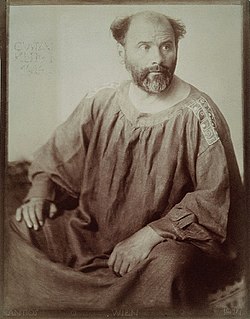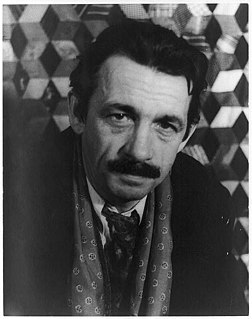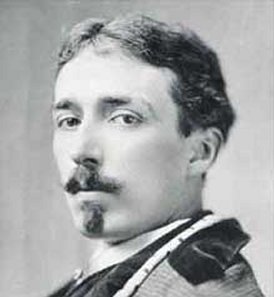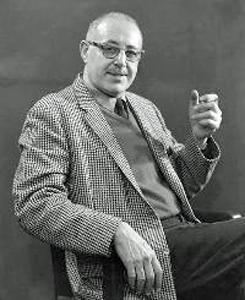
Gustav Klimt was an Austrian symbolist painter and one of the most prominent members of the Vienna Secession movement. Klimt is noted for his paintings, murals, sketches, and other objects d'art. Klimt's primary subject was the female body, and his works are marked by a frank eroticism. Amongst his figurative works, which include allegories and portraits, he painted landscapes. Among the artists of the Vienna Secession, Klimt was the most influenced by Japanese art and its methods.

Oskar Kokoschka was an Austrian artist, poet, playwright, and teacher best known for his intense expressionistic portraits and landscapes, as well as his theories on vision that influenced the Viennese Expressionist movement.

Thomas Hart Benton was an American painter and muralist. Along with Grant Wood and John Steuart Curry, he was at the forefront of the Regionalist art movement. The fluid, sculpted figures in his paintings showed everyday people in scenes of life in the United States. His work is strongly associated with the Midwestern United States, the region in which he was born and which he called home for most of his life. He also studied in Paris, lived in New York City for more than 20 years and painted scores of works there, summered for 50 years on Martha's Vineyard off the New England coast, and also painted scenes of the American South and West.

Joaquín Sorolla y Bastida was a Spanish painter. Sorolla excelled in the painting of portraits, landscapes and monumental works of social and historical themes. His most typical works are characterized by a dexterous representation of the people and landscape under the bright sunlight of Spain and sunlit water.

Man at the Crossroads (1934) was a fresco by Diego Rivera in New York City's Rockefeller Center. It was originally slated to be installed in the lobby of 30 Rockefeller Plaza, the main building of the center. Man at the Crossroads showed the aspects of contemporary social and scientific culture. As originally installed, it was a three-paneled artwork. A central panel depicted a worker controlling machinery. The central panel was flanked by two other panels, The Frontier of Ethical Evolution and The Frontier of Material Development, which respectively represented socialism and capitalism.

James Carroll Beckwith was an American landscape, portrait and genre painter whose Naturalist style led to his recognition in the late nineteenth and very early twentieth century as a respected figure in American art.

F. Winold Reiss was a German-born American artist and graphic designer. He was born in Karlsruhe, Germany, the second son of Fritz Reiss (1857–1914) and his wife. He grew up surrounded by art, as his father was a well-known landscape artist and his brother became a sculptor.

Chaim Gross was an American sculptor and educator.

George Biddle was an American painter, muralist and lithographer, best known for his social realism and combat art. A childhood friend of President Franklin D. Roosevelt, he played a major role in establishing the Federal Art Project (1935–43), which employed artists under the Works Progress Administration.

Harry Sternberg was an American painter, printmaker and educator. He was born in New York City on July 19, 1904 and died in Escondido, California on November 27, 2001.
Boleslaw Cybis (1895–1957) was a Polish painter, sculptor, and muralist.
SisterMaria Stanisia, S.S.N.D., was an American Catholic nun, artist and painter, member of the School Sisters of Notre Dame.

Henry Varnum Poor was an American architect, painter, sculptor, muralist, and potter. He was a grandnephew of the Henry Varnum Poor who was a founder of the predecessor firm to Standard & Poor's.
Jesús Guerrero Galván was a Mexican artist, a member of the Mexican muralism movement of the early 20th century. He began his career in Guadalajara but moved to Mexico City to work on mural projects in the 1930s for the Secretaría de Educación Pública and Comisión Federal de Electricidad In addition, he did easel paintings, with major exhibitions in the United States and Mexico. In 1943, he was an artist-in-residence for the University of New Mexico, painting the mural Union of the Americas Joined in Freedom, considered to be one of his major works. Guerrero Galván was accepted as a member of the Salón de la Plástica Mexicana.

Mexican muralism was the promotion of mural painting starting in the 1920s, generally with social and political messages as part of efforts to reunify the country under the post-Mexican Revolution government. It was headed by "the big three" painters, Diego Rivera, José Clemente Orozco and David Alfaro Siqueiros. From the 1920s to about 1970s many murals with nationalistic, social and political messages were created on public buildings, starting a tradition which continues to this day in Mexico and has had impact in other parts of the Americas, including the United States, where it served as inspiration for the Chicano art movement.
Joy Postle was a pioneering American environmental artist and creator of celebrated murals depicting Florida wildlife.

Carry Hauser, born Carl Maria Hauser, was an Austrian painter, stage set designer and poet.

Anna Massey Lea Merritt was an American painter and printmaker active in Great Britain. She painted portraits, landscapes and religious scenes. She was born in Philadelphia but lived and worked abroad most of her life in Britain. Merritt worked as a professional artist for most of her adult life, 'living by her brush' before her brief marriage to Henry Merritt and after his death.

Frederick Ruple was a 20th-century Swiss-American painter, primarily of portraits. He was commissioned to paint Confederate Civil War battle scenes and murals. At times Ruple lived in Arkansas and Oklahoma where he traveled to study American Indians and early settlement in the Midwest. The Oklahoma Land Run of 1889 inspired Ruple to create his most famous painting "The Spirit of '89".

The Franklin Building is a 14-story brick building on Printer's Row in Chicago, Illinois, located at 720 South Dearborn Street. It is one of the historic buildings in the City of Chicago Printing House Row landmark district. The building was designed by George C. Nimmons for the Franklin Printing Company and built in 1916 following on the company's previous building at 523 Dearborn, which was constructed in 1886. The current building is an example of Chicago School architecture. Oskar Gross, a painter from Vienna, Austria, did a mural over the main entrance and painted tiles for the building depicting an artist, engraver, typesetter, bookbinder, and other artisans involved in the printing process.
















